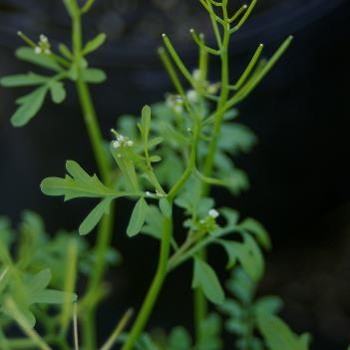Cardamine spp.
Bittercress, or Cardamine spp., are common cool-season weeds but are persistent in shaded, moist environments year-round. With more than 200 species worldwide, bittercress weeds can be found on every continent except Antarctica. Several species of bittercress are problematic to nursery production. In Florida, hairy bittercress (Cardamine hirsuta) and Pennsylvania bittercress (Cardamine pensylvanica) are the most problematic.
Hairy bittercress (Cardamine hirsuta) occurs throughout the year in Florida in shaded and moist areas but is most problematic in the fall through the spring during cooler temperatures, which are more favorable for germination and growth. A prolifent seed producer, letting this plant go to seed should be avoided.
Pennsylvania bittercress (Cardamine pensylvanica) is a native Florida landscape weed. A favorite of pollinators, this species is also an issue because it is a common host for many insect pests. This species naturally occurs in 60% of Florida counties. All photos are of Cardamine pensylvanica.
- Scientific Name: Cardamine spp.
- Common Name: Bittercress
- Seasonality: Traditionally cool-season but can grow year-round
- Soil Type: Wet
- Toxicity: Non-Toxic
- Most Commonly Found: In disturbed areas; shores of rivers, lakes, swamps and wetlands; in greenhouses, container pads, growing media, and nursery pots. It is most often found in irrigated or shaded areas but can grow in full sun.
- Biology and Management of Hair Bittercress (Cardamine hirsuta) in Ornamental Crop Production
-
Relevant Resources
USDA Plant Profile: https://plants.usda.gov/core/profile?symbol=CAPE3
Illinois Wildflowers: https://www.illinoiswildflowers.info/woodland/plants/pn_bittercress.htm
Lady Bird Johnson Wildflower Center: https://www.wildflower.org/plants/result.php?id_plant=cape3




